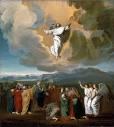
The Ascension of Jesus into heaven brings to a conclusion the resurrection story, where he has been transformed into a new life. The three evangelists Mark, Matthew and John give very little detail about Jesus’ ascent to his father. Only Luke writes an account in Acts, which has the same drama as other men like Elijah being taken up into heaven. It is possible that Luke - who was writing for a gentile, probably Greek-speaking, audience - wanted to emphasise for them the majesty of Jesus. They would have images of gods living above on Mount Olympus, so the picture of the Lord ascending from the mountain would resonate with them. The cloud which took him from their sight is a symbol of God’s presence often used in the bible.
However, all four gospels end with a sense of mission. Jesus,limited in time and space as a human being, now lives on in his followers as they do his work. He is present in each of his brothers and sisters and in the Eucharist. His Body is now the community of believers.
As author of both the Gospel and Acts, Luke - as a good story-teller - wants to make all this clear, and in Acts he uses his account of the Ascension as a bridge, linking his two works so that his readers can more easily come to an understanding of the great event of Pentecost.
“God goes up with shouts of joy; the Lord goes up with trumpet blast.” (psalm 46)